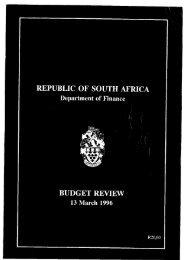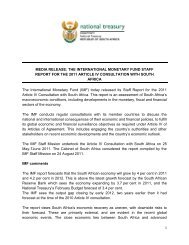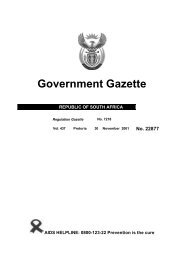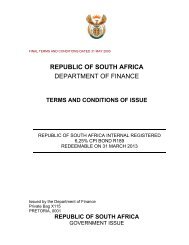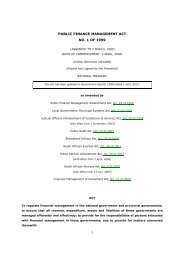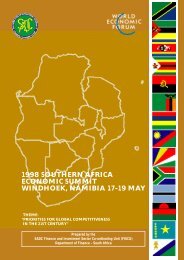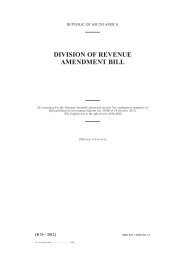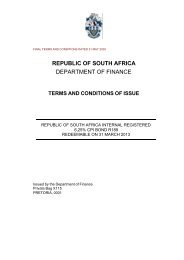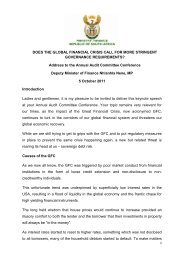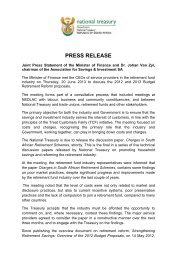Annual Performance Plan Jaarlikse ... - National Treasury
Annual Performance Plan Jaarlikse ... - National Treasury
Annual Performance Plan Jaarlikse ... - National Treasury
Create successful ePaper yourself
Turn your PDF publications into a flip-book with our unique Google optimized e-Paper software.
►PM221: Percentage of learners in Grade 9 attaining acceptable educational outcomes in all learning areas<br />
This performance measure indicates the percentage of all Grade 9 learners who, on average, attain acceptable educational<br />
outcomes.<br />
►PM301: Percentage of funded independent schools visited for monitoring purposes<br />
This is the percentage of independent schools receiving a government subsidy that are visited for quality control purposes by<br />
the Department during the year. It is important that government should monitor the quality of education occurring in<br />
independent schools, and especially those receiving state subsidies, and take action where minimum standards are not met.<br />
►PM401: Percentage of children with special needs of compulsory school going age not enrolled in educational<br />
institutions<br />
This is the percentage of disabled children of compulsory school-going age not enrolled in any educational institution. It is<br />
important that government should provide sufficient and appropriate access to special and public ordinary schools for these<br />
learners. Ideally, this performance measure should carry a value of 0%.<br />
►PM501: Number of FET college students relative to youth in the province<br />
This is the number of FET college students, of all ages, divided by youth aged 16 to 18. Whilst many FET college students<br />
would be above age 18, this performance measure nonetheless provides a useful indication of how well FET colleges are<br />
reaching out to the youth and the population as a whole.<br />
►PM502: Percentage of female students who are in technical fields<br />
This is the percentage of all female FET college students who are enrolled in engineering or other technical fields.<br />
Historically, enrolment of females in these fields has been low. In the interests of gender equity, this situation should<br />
improve.<br />
►PM503: FET college throughput rate<br />
This is the number of students who pass the final examinations, divided by the total number of students who entered the FET<br />
college system with the intention of passing the examinations.<br />
►PM504: Percentage of learners placed in learnerships through FET colleges<br />
This is the learners in learnerships receiving their training through an FET college, as a percentage of all learners in<br />
learnerships in the province. This performance measure indicates how effective FET colleges are at attracting learners from<br />
the learnership system.<br />
►PM601: Percentage of ABET learners relative to adults in the province<br />
This is the percentage of students enrolled in public ABET centres, divided by the total number of adults in the population.<br />
This percentage provides an indication of how extensive the public provisioning of ABET is in the province.<br />
►PM701: Percentage of learners in publicly funded Grade R<br />
This is the total number of learners in publicly funded Grade R (in public schools or community centres), divided by all five<br />
year olds in the population. Whilst it is not government’s aim to reach 100% with respect to this performance measure (some<br />
learners can be expected to attend private centres), policy stipulates that by 2010 we should have reached a high level, of<br />
between 80% and 90%.<br />
<strong>Annual</strong> <strong>Performance</strong> <strong>Plan</strong> 2007/08 – 2009/10<br />
82



